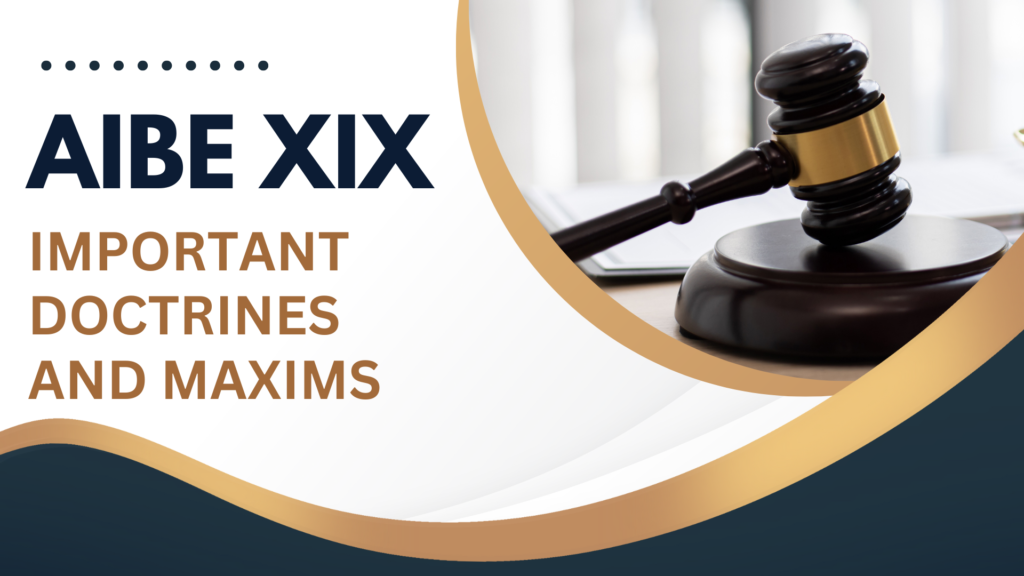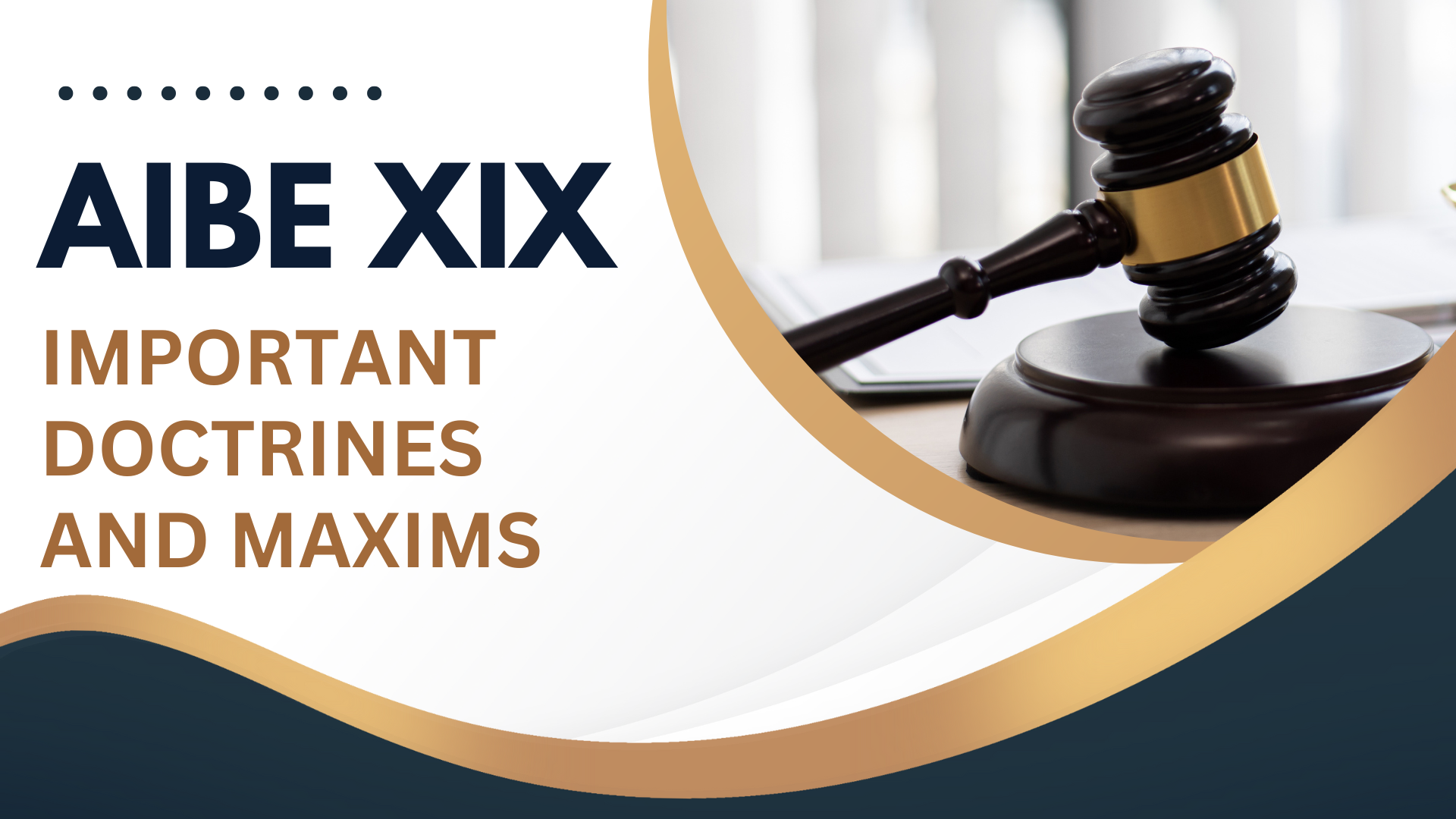Legal doctrines form the backbone of judicial systems worldwide. They provide principles that guide courts in resolving disputes, interpreting laws, and delivering justice. Here, we explore some of the most significant legal doctrines, their meanings, and practical implications in law.

Doctrine of repugnancy
- Meaning: The doctrine of repugnancy is a constitutional concept in India that addresses conflicts between laws that produce different results when applied to the same facts:
- Explanation: The doctrine of repugnancy is defined as inconsistency or contradiction between two or more parts of a legal instrument.
Actus non facit reum, nisi mens sit rea
- Meaning: An act does not make a person guilty unless there is a guilty mind.
- Explanation: This maxim highlights the importance of intention in criminal liability. It signifies that to constitute a crime, the mental state (mens rea) of the accused must align with the wrongful act (actus reus). Without mens rea, many acts cannot be considered crimes under the law.
Pacta sunt servanda
- Meaning: Agreements must be kept.
- Explanation: This principle emphasizes that contracts or agreements are binding and should be performed as agreed upon by the parties. It is a cornerstone of contract law, ensuring the enforcement of legal commitments.
Res ipsa loquitur
- Meaning: The thing speaks for itself.
- Explanation: Used primarily in tort law, this maxim indicates that the occurrence of an accident implies negligence without requiring detailed evidence. For example, a surgical instrument left inside a patient post-surgery is an evident case where negligence is presumed.
Ubi jus ibi remedium
- Meaning: Where there is a right, there is a remedy.
- Explanation: This principle underscores that every legal right is paired with a legal remedy. If a right is violated, the aggrieved party is entitled to seek redress or compensation through the legal system.
Injuria sine damno
- Meaning: Legal injury without damage.
- Explanation: This refers to cases where a legal right is violated, but no actual harm or damage is suffered by the individual. For example, unauthorized entry into someone’s property is an infringement of their legal right even if no material damage occurs.
Nemo debet bis vexari pro uno et eadem causa
- Meaning: No one should be vexed twice for the same cause.
- Explanation: This is the foundation of the doctrine of double jeopardy, preventing a person from being tried again for the same offense once they have been acquitted or convicted.
Qui facit per alium facit per se
- Meaning: He who acts through another does the act himself.
- Explanation: This maxim applies to the law of agency, where actions performed by an agent on behalf of the principal are considered as actions of the principal.
Consensus ad idem
- Meaning: Meeting of the minds.
- Explanation: This refers to mutual agreement and understanding among parties about the terms of a contract, which is essential for the formation of a valid agreement.
Vis major
- Meaning: Act of God.
- Explanation: Refers to extraordinary events or natural disasters (like floods, earthquakes) that cannot be foreseen or prevented and absolve parties from liability for breach of contract2.
Damnum sine injuria
- Meaning: Damage without legal injury.
- Explanation: This maxim signifies that not all damages are actionable. If no legal right has been violated, a person cannot claim compensation for harm suffered, as seen in Gloucester Grammar School Case .
Res Sub judice
- Meaning: A matter under judicial consideration.
- Explanation: Prevents courts from proceeding with a case that is already being tried in another court to avoid contradictory rulings, provided under Section 10 of CPC .
Interesut sit finis litium
- Meaning: It is in the interest of the state that there should be an end to litigation.
- Explanation: Forms the basis of the doctrine of res judicata. It aims to prevent endless disputes by ensuring that a final decision is conclusive .
Qui facit per alium
- Meaning: He who acts through another does the act himself.
- Explanation: This is often applied in agency law, indicating that an agent’s acts are legally considered acts of the principal .
Delegatus non potest delegare
- Meaning: A delegate cannot delegate.
- Explanation: This maxim indicates that a person who has been delegated authority by another cannot further delegate that authority to someone else without express permission. This principle is often applied in administrative law and governance to ensure accountability.
Caveat emptor
- Meaning: Let the buyer beware.
- Explanation: This principle places the onus on buyers to conduct due diligence before making purchases. It serves as a warning that the buyer assumes the risk regarding the quality or condition of goods.
Ex dolo malo non oritur actio
- Meaning: No action arises from deceitful conduct.
- Explanation: This maxim asserts that a person cannot bring a legal action if it stems from their own illegal or unethical conduct.
Nemo moriturus praesumitur mentiri
- Meaning: A dying man is presumed not to lie.
- Explanation: This principle underlies the admissibility of dying declarations in evidence. It is assumed that a person on their deathbed would not risk their eternal soul by speaking falsehoods.
ublicae ut sit finis litium
- Meaning: It is in the interest of the state that there should be an end to litigation.
- Explanation: This maxim supports doctrines like res judicata, preventing repetitive litigation over the same matter.
Doctrine of Res Judicata
- Meaning: Once a matter is adjudicated, it cannot be litigated again between the same parties.
- Explanation: This principle, codified in Section 11 of the Civil Procedure Code (CPC), ensures judicial finality by barring the re-litigation of disputes already resolved.
Doctrine of Pleasure
- Meaning: Civil servants hold office at the pleasure of the President or Governor.
- Explanation: Under Article 310 of the Indian Constitution, this doctrine provides that the tenure of a civil servant is subject to the pleasure of the appointing authority, subject to conditionsof Rule of Law.
Rule of law
- Meaning: Supremacy of law over all individuals and government actions.
- Explanation: This principle ensures equality before the law and prevents arbitrary governance. It is a foundational concept for democratic legal systems .
Doctrine of Basic Structure
- Constitution’s fundamental features cannot be altered by amendments.
- Explanation: Established in the Keshavananda Bharati case, it prevents Parliament from enacting constitutional amendments that undermine the Constitution’s core values .
Doctrine of Legitimate Expectation
- Meaninls can expect consistent and fair behavior from public authorities.
- Explanation: Ensures fairness in administrative actions where there is an implied promise or established practice .
Doctrine of Severability
- Meaning: Invalid portions of a statutated, preserving the valid parts.
- Explanation: Ensures the enforcement of constitutional provisions by isolating unconstitutional clauses .
Doctrine of Colourable Legislation
- Meaning: What cannot be done directly cannot be done indirectly. The doctrine of colourable legislation is a legal principle that aims to prevent the excessive unconstitutional use of the legislative authority of the government. This doctrine is also termed as the ‘Fraud on the Constitution’.
- Explanation: Ensures that legislatures do not transgress their jurisdiction under the guise of exercising their legislative powers .
Doctrine of Pith and Substance
- Meaning: Focus on the true nature of legislation rather effects.
- Explanation: Pith means “true nature” or “essence of something”, and substance means “the most important or essential part of something
Doctrine of Estoppel
- Meaning: A person is prevented from asserting something contrary to what they previously implied.
- Explanation: Prevents injustice by ensuring consistency in declarations and conduct .
Doctrine of Territorial Nexus
- Meaning: States can legislate on matters outside their territory if there is a sufficient nexus.
- Explanation: This doctrine under Article 245 of the Constitution validates laws made by a state for events or objects beyond its geographical boundaries, provided there is a significant connection.
Doctrine of Prospective Overruling
- Meaning: A judicial decision applies to future cases only, not retroactively.
- Explanation: Introduced by the Supreme Court in Golaknath v. State of Punjab, it ensures that decisions do not disrupt settled legal rights based on past actions.
Doctrine of Harmonious Construction
- Meaning: This doctrine states that when there are conflicts between laws, the interpretation should be such that the spirit and essence of both laws are maintained. The goal is to give effect to all the provisions of the laws.
- Explanation: It ensures the effective application of both provisions without rendering one redundant or ineffective.
Doctrine of Judicial Review
- Meaning: Courts have the power to examine the constitutionality of legislative or executive actions.
- Explanation: Derived from Article 13, it is a cornerstone of the Constitution, protecting fundamental rights and upholding the rule of law.
Doctrine of Double Jeopardy
- Meaning: A person cannot be tried twice for the same offense.
- Explanation: Article 20(2) of the Constitution embodies this doctrine, ensuring protection against repetitive prosecution.
Doctrine of Eclipse
- Meaning: A law inconsistent with fundamental rights is dormant, not void.
- Explanation: It can be revived if the constitutional inconsistency is resolved through amendments .
Doctrine of laches.
- Meaning: Legal remedies are denied to those who delay unreasonably in asserting them.
- Explanation: This principle discourages litigants from being negligent in protecting their rights.
Doctrine of Election
- Meaning: A person benefiting from an instrument must accept its burdens.
- Explanation: This principle prevents an individual from simultaneously claiming inconsistent rights under the same instrument or statute.
Doctrine of Necessity
- Meaning: Certain actions that are otherwise unlawful may be justified by necessity.
- Explanation: This doctrine is often invoked in administrative law or during emergencies to validate acts essential to prevent greater harm.
Doctrine of Ultra Vires
- Meaning: Actions taken beyond the powers conferred by law or authority are invalid.
- Explanation: Frequently applied to assess the validity of legislative and executive actions, ensuring adherence to legal boundaries.
Doctrine of Public Trust
- Meaning: The state holds natural resources in trust for public use.
- Explanation: Emphasized in environmental law, it limits the government’s ability to transfer control over essential resources to private entities.
Doctrine of Rule of Law
- Meaning: Law is supreme, and no one is above it.
- Explanation: Enforces equality before the law and ensures that all actions are subject to legal standards.
Doctrine of Separation of Powers
- Meaning: Government powers are divided among legislative, executive, and judicial branches.
- Explanation: Promotes checks and balances, ensuring that no branch usurps the functions of another
Doctrine of Lis Pendens
- Meaning: The principle that during litigation, nothing new should be introduced to affect the rights of the parties.
- Explanation: Codified under Section 52 of the Transfer of Property Act, 1882, it ensures that the subject matter of litigation remains unaffected during the trial process.
Doctrine of De Minimis Non Curat Lex
- Meaning: The law does not concern itself with trifles.
- Explanation: This principle excludes minor or insignificant issues from judicial consideration to save time and resources.
Durham Doctrine
Explanation: This doctrine assesses criminal liability based on mental capacity and understanding at the time of the offense
Meaning: An accused is not criminally liable if their unlawful act results from a mental defect or disease.





